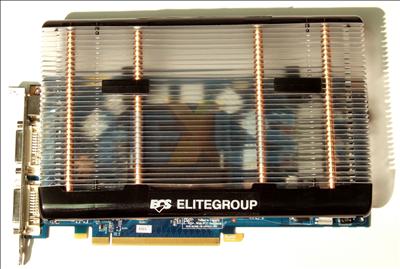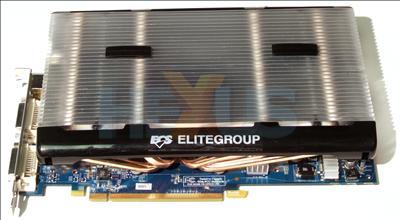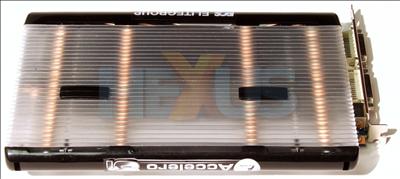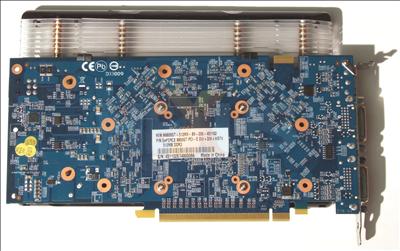ECS N8800GT-512MX DT
First up, the ECS N8800GT-512MX DT.Both ECS and Palit choose to differentiate their GeForce 8800 GT 512MiB offerings from the reference design on two fronts, as both ship with upgraded coolers and are pre-overclocked to GTS 512 speeds of 650/1,620/1,900MHz for the core, shaders, and memory, respectively. The overclocked speeds are comfortably higher than the reference 8800 GT 512 clocks of 600/1,500/1,800MHz, we note.
The ECS is kept cool by the Arctic Cooling Accelero S1 rev.2, which is one of the best aftermarket coolers for a mid-range card. It features four heatpipes and a vast array of fins, and it can be run either passively for complete silence, or with the optional ‘turbo-cool’ fans installed to further reduce temperatures or enable even-higher overclocks.
The first thing you notice about the cooler is its size, spanning the length of the card, and taller than the PCB, it provides plenty of surface area to dissipate the heat the four heat pipes transfer from the core.
The cooler is attached in a two-fold fashion. Firstly, it's positioned on to the GPU-mounting holes and then uses support clips that attach to the PCB. It does have its downsides, because its size may make installation in smaller cases difficult or impossible, and whilst the profile is one of a dual-slot cooler in passive mode, the addition of the turbo-cool module - which may be necessary in cases with low airflow - a third slot is taken up.
In addition to consuming up to three slots, the cooler also obstructs the SLI bridge. This problem is exacerbated due to the lack of a long, flexible SLI cable in the bundle. SLI usage, should you require it, may not be possible on some motherboards, then.
The card requires the use of a single six-pin PCIe power connector. From this angle you can also see that the memory chips and VRMs are covered by simple aluminium heatsinks. Whilst the heatsink cooling the core has a large surface area to facilitate passive operation, the memory and VRMs are still reliant on case airflow to keep them within operating tolerances.
Two HDCP-enabled, dual-link DVI ports and TV-out adorn the backplate. Whilst only one backplate is taken up, the second backplate slot is likely to be unavailable even for port-expansion brackets due to the cooler. A dual-slot backplate with HDMI-out, or even vent holes, would have been preferable given that the adjacent PCI bracket is unavailable. It would have better-secured the card to the case. As it stands, the bracket will likely be left without a blanking plate in most setups, in order to provide additional ventilation.















